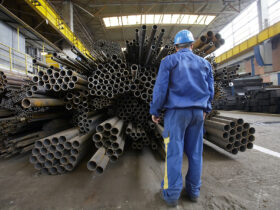Introduction
The Dow Jones Industrial Average (DJIA), often referred to simply as “the Dow,” represents a critical barometer for the economic health not only of the United States but, in many ways, the global economy. Encompassing a wide array of industries – from technology to healthcare, the Dow’s fluctuations are intimately tied to a multitude of international events and shifts. Whether it’s geopolitical tension, global pandemic, or breakthrough innovation, events that ripple through our world often find a reflection in the metrics of this prominent index. This article endeavors to dissect the multifaceted impacts of several pivotal global events on the Dow, providing a lens through which we might better understand its oscillations and, by extension, the global economic landscape.
The Dow Jones – A Brief Overview
Before delving into the nuanced impacts of global happenings, an understanding of the dow jones Industrial Average is paramount. Established in 1896 by Charles Dow and Edward Jones, the DJIA has evolved, becoming not merely a national benchmark for economic prosperity but also a global one. Representing 30 large publicly-owned companies based in the United States, the Dow mirrors the financial health and trends across a swathe of industries, rendering it susceptible to various global occurrences. The methodology of calculating the index and the criteria for company inclusion have underpinned its robustness and relevance across more than a century of change.
Navigating Through Geopolitical Upheavals
Geopolitical events, including wars, elections, and diplomatic tensions, wield a considerable influence over the Dow Jones. For instance, the impact of the U.S. Presidential elections or tensions in oil-rich regions has been palpably observed in the DJIA’s movements. Models such as the Gulf War or the recent U.S.-China Trade War have elucidated the susceptibility of the Dow to geopolitical climates, causing ripples that traverse nations and industries, influencing investment, trade policies, and market confidence on a global scale.
The Economic Ripples of Global Pandemics
Arguably, nothing has spotlighted the Dow’s vulnerability to global events quite like the COVID-19 pandemic. The virus, which reared its head in late 2019, undeniably demonstrated the interconnectedness of modern economies and markets. As nations grappled with the viral onslaught, implementing lockdowns and stalling economic activities, the Dow experienced significant contractions, reflecting not merely the national economic standstill but also the global one. Analyzing such impacts provides insights into not only the financial repercussions of health crises but also the intrinsic global economic interdependencies.
Technological Breakthroughs and Market Responses
The burgeoning advancements in technology have also perennially shaped the dynamics of the Dow Jones. From the advent of the internet to breakthroughs in Artificial Intelligence and renewable energies, technological innovations have consistently reshaped industrial landscapes and, consequently, the composition and trends within the DJIA. Companies that adapt and drive technological innovations often find buoyancy in their market value, while those unable to navigate through the digital transformations may witness a decline, reflections of which are mirrored in the Dow’s movements.
Financial Policy and Regulatory Impacts
Financial policies, including interest rate adjustments, tax modifications, and trade regulations, cast a shadow over the Dow’s performance. Regulatory shifts, both within the U.S. and in its major trading partners, carve out the trajectory of industries and their economic viability. Understanding how these policy shifts, such as changes in the Federal Reserve’s stance or the imposition of trade tariffs, impact the Dow provides a window into the symbiosis between economic policy, global trade, and market health.
Social and Environmental Movements Impacting the Dow
The dawn of the 21st century has seen an unwavering surge in social and environmental movements, which have subtly and overtly shaped Dow Jones and its constituting entities. The burgeoning advocacy for sustainability, climate change policies, and social justice has started wielding influence over investment directions and company policies. Firms enlisted in the DJIA are not impervious to these shifts. The socially responsible investment paradigm, which prioritizes environmental, social, and governance (ESG) factors, has altered traditional investment perspectives and strategies. Companies within the Dow that align with these new societal norms often witness a more favorable market position, whereas those contravening these evolving expectations may encounter reputational and financial setbacks. This section endeavors to unravel the intricate tapestry of how social and environmental movements sculpt the Dow, affecting its dynamics and, potentially, its future trajectory.
The Interplay between Currency Valuations and the Dow
The relationship between the Dow Jones and currency valuation, especially the U.S. Dollar, is a compelling facet of international finance. A seesaw is often observed, where the strengthening of the dollar corresponds with shifts in the Dow, partly due to its impact on international trade and global investment dynamics. U.S. companies listed on the DJIA, which garner substantial revenues from international markets, can experience pronounced results on their earnings and, consequently, stock prices when the dollar fluctuates significantly. This interplay extends beyond the borders of the United States, influencing global investment strategies, trade balances, and economic policy-making across nations. A meticulous exploration of past currency fluctuations and their concurrent impacts on the Dow sheds light on this intricate financial interplay, revealing patterns and insights crucial for investors and policy-makers alike.
Global Commodity Prices and Their Echo on the Dow
The oscillation of global commodity prices, particularly crude oil and precious metals, is closely entwined with the vicissitudes of the Dow Jones Industrial Average. When oil prices climb, energy sector stocks within the Dow may witness a surge, while industries heavily reliant on fuel, such as airlines and manufacturing, may experience the opposite effect. Alternatively, a rise in gold prices, often perceived as a safe-haven asset, might correspond to a decline in the Dow as investors pivot towards stability amid economic tumult. Analyzing the multifaceted repercussions of commodity price variations on the Dow, one acknowledges the interwoven nature of global commodities and stock markets, revealing insights that are pivotal for forecasting, strategizing, and comprehending the interconnected tendrils of the worldwide economy.
Analyzing Investor Sentiment and Psychological Factors
Tangible events or quantifiable shifts do not solely guide the waves within the Dow Jones but are also intimately tied to the often nebulous realm of investor sentiment and psychological factors. Events that stir optimism or fear among investors, even when their tangible impact on the economy or individual companies might be minimal, can catalyze notable shifts within the Dow. For instance, political instability, emerging technologies, or unexpected global events, without directly impacting economic fundamentals, can nonetheless incite palpable fluctuations in the Dow, driven by investor perception, confidence, and resultant behavior. A comprehensive analysis entails not merely exploring the tangible but also deciphering the intangible psychological and behavioral facets that navigate the Dow’s course through the global economic seas.
Also, Read The Following: great western buildings lawsuit










Leave a Reply